I thought it would be appropriate to re-run a column I wrote back in 2018, about a new driver that was coming into the NASCAR Cup Series. Darrell Wallace Jr., better known around the garages as “Bubba”. He would be driving for The King, Richard Petty, in his #43 Camaro in 2018. The column was written after the media event put together by the Las Vegas Speedway, and every year since that first meeting he has remained a truly wonderful young man to meet and know. The reason of course is simple; “Bubba” was leading the YellaWood 500 at Talladega a week ago Monday, Oct. 3, when the rain began to fall on the huge speedway with five laps remaining. Of course the race was stopped to wait out the rain. Well the rest is now history. The rain never stopped. Bubba was declared the winner! It was also his first Cup series win, and the first for his new team. Wallace had moved over to the new team this year. The team is 23XI Racing (pronounced twenty-three eleven) and he drives the #23 Toyota in the NASCAR Cup Series. The team is owned and operated by Hall of Fame basketballplayer Michael Jordan, with current Joe Gibbs Racing driver Denny Hamlin as a minority partner. I hope you enjoy reading the following column:
Went to a meet and greet media event the other day to meet and interview a young gentleman named Darrell “Bubba” Wallace, Jr. What was so interesting about Wallace, that a special media event was held? Nothing much, except that he has been signed to drive the legendary #43 Chevrolet Camaro for the Richard Petty (the original driver of the number 43) Motorsports, beginning with the Daytona 500 in February. Oh, did I forget to mention that the 24- year-old lad from Concord, North Carolina, is African American?
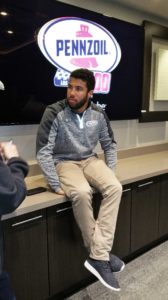
Wallace follows several African Americans who have climbed some tall ladders in attempting to make a mark in various American auto racing organization. Before I get into Wallace, and how he had earned the ride in the #43, I’d like to sorta take you down a path of hard knocks, so that a Wallace and others could no longer be ignored. One of the earliest that I could find dated back as far as the early 1900s, where people of color had been making considerable contributions to the sport of auto racing.
An early pioneer of Blacks on the racetrack was Charlie Wiggins, who fought racial segregation in the sport during the turn of the 20th century, and especially after repeatedly being denied to race in the Indianapolis 500, which had its first race in May 1911. Wiggins and other Black drivers formed their own racing association and thereby competed among themselves. Dubbed “The Negro Speed King,” Charlie won three of the first six races of the Gold & Glory Sweepstakes, an annual 100-mile speed race for Black drivers. A skilled mechanic, Wiggins was asked by Wild Bill Cummings, a top White AAA (American Automobile Association) competitor, to serve in his pit crew for the Indianapolis 500. Due to the raceways strict rules of segregation, he was officially hired as a janitor, while secretly tuning up Cummings race car for the races, and in 1934 Cummings won the Indy 500. During the 1936 Gold & Glory Sweepstakes, Charlie was involved in a 13-car wreck that resulted in his right leg being amputated, abruptly ending his racing career, as well as the future of the all-Black event, which lost its biggest star. Despite his injury Wiggins continued to fight the segregationist practices of the American Automobile Association, while also training young Black mechanics until his death in 1979 at the age of 82.
The next major movement, that caught the attention of American auto racing, occurred on March 4, 1961, when a 40-year-old Black African named Wendell Scott pulled his Chevrolet into the line-up at the Spartanburg, South Carolina Speedway, ending a nine-year campaign of racing in the NASCAR minor leagues. Scott didn’t finish that first race, but for the rest of his career he raced in the top tier of NASCAR, the Grand Nationals, later the Winston Cup, and today known as the Monster Energy Cup. On December 1, 1963, at the age of 42, Scott won a Grand National Series race at Speedway Park in Jacksonville, Florida, becoming the first black driver to win a race at NASCAR’s premier level. Wendell Scott was posthumously inducted into the NASCAR Hall of Fame in 2015.
Only seven other African-American drivers are known to have started at least one race in what is now the Monster Energy Cup Series: Elias Bowie, Charlie Scott, George Wiltshire, Randy Bethea, Willy T. Ribbs, Bill Lester, and most recently “Bubba” Wallace in 2017. Those drivers have made a combined eleven Cup starts. Of those, only Wallace, Ribbs and Lester ever raced at the Las Vegas Motor Speedway (LVMS). Ribbs, who entered the NASCAR Cup series in 1986, raced in three Cup races, then moved on to race in the NASCAR Truck series, finishing 25th in 2001 at the LVMS. Lester raced once in a Busch series event in 1999, moving to the Truck series in 2002, racing five times at the LVMS, with a best finish of 17th in 2002. Bill made his first Cup race in March 2006 in the Golden Corral 500 at Atlanta Motor Speedway. Lester is currently racing sports cars in the Rolex Grand Am series.
And, on Sunday, February 18, 2018, a dream that started when he was nine years of age, will take place when “Bubba” Wallace pulls his #43 Chevrolet into the line for the start of the NASCAR Daytona 500 Monster Cup series race. Wallace had previously raced on the Daytona Speedway, in both the Truck and Xfinity series, but this would be the Big Race! Wallace also would have a multi-year contract with full sponsorship in his hip pocket.
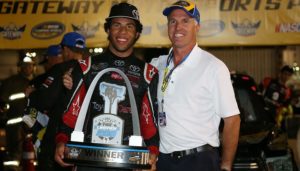
And, gang, this was not something that came easy. “I was lucky that my dad was able to sponsor me during my early years of competition,” he told me. “I got started when I was nine (2002) racing in Go-Karts, Bandolero, and the Legends series, as well as local late model events.” Soon he was racing every week, winning 35 of the Bandolero Series’ 48 races in 2005. “Even with a winning season, and moving up to the modified K&N East series, it still takes sponsorships. I was constantly on the phone. It takes persistence to get sponsorships,” Wallace said with a grin.
In 2010, Wallace began competing in the NASCAR K&N Pro Series East, a regional and developmental series. Eventually he signed as a development driver for Joe Gibbs Racing, winning his very first race in the series, at Greenville-Pickens Speedway, becoming the youngest driver (19) to ever win at the track. “Bubba” finished the season third in series points and won the series’ Rookie of the Year award. Wallace’s 2011 season would see him winning three times, finishing the season second in points to Max Gresham. In 2012 Darrell raced the entire K&N East Series season along with four to six selected races in the Nationwide Series.
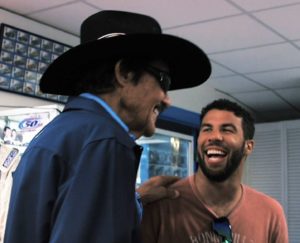
In February 2013, it was announced that Wallace would run a full season in the Camping World Truck Series in the No. 54 Toyota owned by Kyle Busch Motorsports. On October 26, 2013, Wallace became the first African-American driver to win in one of NASCAR’s national series since 1963, winning the Camping World Truck Series Kroger 200 at Martinsville Speedway. Wallace finished 8th in points in his rookie season. In 2014, Wallace returned to the Camping World Truck Series full-time in the No. 54; he also raced in the Nationwide Series for Joe Gibbs Racing (JGR) in the No. 20, starting in May at Talladega Superspeedway. Wallace switched to the No. 34 for the Kroger 200 at Martinsville in tribute to Wendell Scott, taking home the checkered flag for the second time. On December 8, 2014, Wallace announced he had been granted his request to leave JGR and seek other opportunities. On January 28, 2015 it was announced that Wallace would drive the No. 6 Ford EcoBoost Mustang for Roush Fenway Racing in the Xfinity series.
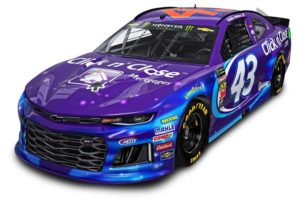
Wallace started the season with a 12th place finish at Daytona and earned 14 top-ten finishes, placing him 7th in the final point standings. In 2017 “Bubba” finished 33rd in the season-opening race at Daytona, and went on to finish in sixth place five consecutive times. On June 5, Richard Petty Motorsports signed Wallace drive the team’s No. 43 Ford in place of injured Aric Almirola, making him the first African-American to race in the Cup Series since Bill Lester in 2006. Roush Fenway announced that they would be suspending operations of Wallace’s Xfinity Series team following the Pocono race weekend due to sponsorship issues. In qualifying for his Cup debut at the Pocono 400, he was able to advance to the second round and start 16th. Wallace earned a career best finish of 11th at Kentucky which would be his last start in the No. 43. Wallace returned to the Camping World Truck Series at Michigan in August, driving the No. 99 Truck for MDM Motorsports.
Wallace was officially introduced to the #43 team as their new driver on October 25. At the same time Petty revealed they would be changing from racing for Ford, to race Chevrolets in 2018. He will be the first African-American driver to have a full time Cup ride since Wendell Scott in 1971.
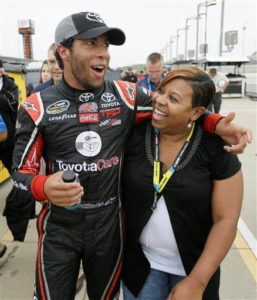
Two of those standing on the Daytona Track as “Bubba” Wallace prepares to climb into his race car, will be his proud parents: Darrell Wallace, Sr., an owner of an industrial cleaning company, and his mother, Desiree, who is a social worker. They knew about the dream their son had and they made sure he had the means to go for it. The rest, as Wallace, Jr., said, “was left up to me. It took a lot of phone calls, and persistence to find and grab hold of every opportunity. It was a tough road, but a great road, and the rest is now up to me!”
I think Charlie Wiggins and Wendall Scott will be looking down on Darrell Wallace, Jr., as the historic #43 circles the Daytona track and shoots down the track towards the green flag, and races towards turn one and into the history books. A historic car, a historic number, and history in the making. Wow, I can’t wait to watch the race on TV, and then to watch him live at the Las Vegas Motor Speedway on March 4, 2018.
Well, gang, that’s about it for this week.